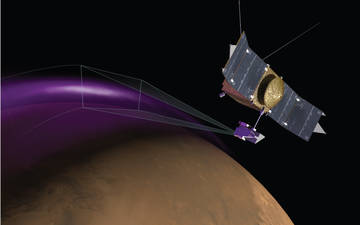
Artist's conception of MAVEN's Imaging UltraViolet Spectrograph (IUVS) observing the "Christmas Lights Aurora" on Mars. MAVEN observations show that aurora on Mars is similar to Earth's "Northern Lights" but has a different origin. Image Credit: University of Colorado
WASHINGTON (PTI): NASA's MAVEN spacecraft has observed two unexpected phenomena in the Martian atmosphere: a mysterious high-altitude dust cloud and a deep bright ultraviolet aurora.
The presence of the dust at orbital altitudes from about 150 kilometres to 300 kilometres above the surface was not predicted, NASA said.
Although the source and composition of the dust are unknown, there is no hazard to Mars Atmosphere and Volatile Evolution (MAVEN) and other spacecraft orbiting Mars.
"If the dust originates from the atmosphere, this suggests we are missing some fundamental process in the Martian atmosphere," said Laila Andersson of the University of Colorado's Laboratory for Atmospherics and Space Physics (CU LASP), Boulder, Colorado.
It is unknown if the cloud is a temporary phenomenon or something long lasting. The cloud density is greatest at lower altitudes.
However, even in the densest areas, it is still very thin.
So far, no indication of its presence has been seen in observations from any of the other MAVEN instruments.
Possible sources for the observed dust include dust wafted up from the atmosphere; dust coming from Phobos and Deimos, the two moons of Mars; dust moving in the solar wind away from the Sun; or debris orbiting the Sun from comets.
However, no known process on Mars can explain the appearance of dust in the observed locations from any of these sources.
MAVEN's Imaging Ultraviolet Spectrograph (IUVS) observed what scientists have named "Christmas lights." For five days just before December 25, MAVEN saw a bright ultraviolet auroral glow spanning Mars' northern hemisphere.
Aurora, known on Earth as northern or southern lights, are caused by energetic particles like electrons crashing down into the atmosphere and causing the gas to glow.
"What's especially surprising about the aurora we saw is how deep in the atmosphere it occurs - much deeper than at Earth or elsewhere on Mars," said Arnaud Stiepen, IUVS team member at the University of Colorado.
"The electrons producing it must be really energetic," said Stiepen.
The source of the energetic particles appears to be the Sun. MAVEN's Solar Energetic Particle instrument detected a huge surge in energetic electrons at the onset of the aurora.
Billions of years ago, Mars lost a global protective magnetic field like Earth has, so solar particles can directly strike the atmosphere, researchers said.
The electrons producing the aurora have about 100 times more energy than you get from a spark of house current, so they can penetrate deeply in the atmosphere.
MAVEN was launched to Mars in 2013 to help solve the mystery of how the Red Planet lost most of its atmosphere and much of its water.
 Previous Article
Previous Article Next Article
Next Article













The Indian Air Force, in its flight trials evaluation report submitted before the Defence Ministry l..
view articleAn insight into the Medium Multi-Role Combat Aircraft competition...
view articleSky enthusiasts can now spot the International Space Station (ISS) commanded by Indian-American astr..
view article